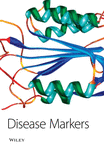Urinary Chiro- and Myo-Inositol Levels as a Biological Marker for Type 2 Diabetes Mellitus
Abstract
Background: The aim of this study was to investigate the role of the urinary chiro- and myo-inositol levels in predicting type 2 diabetes mellitus (T2DM).
Subjects and methods: A total of 212 normal controls and 101 type 2 diabetic patients were enrolled this study. The concentrations of urinary chiro- and myo-inositol were measured by high performance liquid chromatography/mass spectrometry.
Results: The concentration of urinary chiro-inositol was significantly higher in the diabetic subjects (2.24 ± 5.18 ng/L) than those in the control group (0.38 ± 0.62 ng/L; p < 0.001). The urinary myo-inositol level of the diabetic subjects (36.95 ± 37.77 ng/L) was also significantly higher than that of the controls (8.17 ± 13.29 ng/L; p < 0.001). The urinary chiro-inositol multiplied by myo-inositol level of the diabetic subjects (148.10 ± 544.91) was significantly higher than in the controls (5.12 ± 24.15; p < 0.001). The area under the receiver operating characteristic curve for the urinary chiro-inositol multiplied by myo-inositol level to predict T2DM was 0.840 (confidence interval 0.789–0.891, p < 0.001). The cut-off value for the urinary chiro-inositol multiplied by myo-inositol level to predict T2DM was 2.20 (sensitivity 81.3%, specificity 70.3%).
Conclusions: The urinary chiro- and myo-inositol concentrations were increased in the type 2 diabetic patients and the urinary chiro- times the myo-inositol was considered to be a sufficient marker in predicting T2DM.




